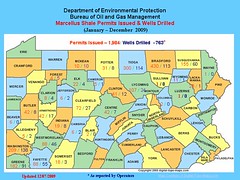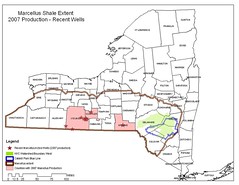New Limits to Take Effect by
The department made the announcement at a public meeting of the Marcellus Shale Wastewater Technology Partnership and said the new limits will protect aquatic life and drinking water supplies.
"High total dissolved solids in industrial wastewater have been a problem in the Monongahela River recently and are an impending problem on a statewide level," Hanger said. "We are establishing base standards for this water so dischargers move towards actually treating TDS in industrial wastewater, rather than simply depending on dilution to protect water quality."
The state's rivers and streams are also burdened by uncontrolled discharges from abandoned coal mines.
Wastewater from certain industrial operations is high in chlorides (salt) and sulfates which affect the taste and odor of drinking water and, in high concentrations, can damage or destroy aquatic life. Drinking water treatment facilities are not normally equipped to treat these contaminants and rely on normally low levels of chlorides and sulfates in surface waters used for drinking water supplies.
"DEP and the natural gas drilling industry created the wastewater technology partnership in 2008 to investigate and deploy new technologies for treating wastewater from natural gas drilling and production within two years," Hanger said. "It is vital that new treatment methods are instituted so that public municipal drinking water supplies and other industrial uses are not disadvantaged by increased total dissolved solids and chlorides in our surface waters and that developing our natural gas reserves is not unduly constrained."
The new permitted limit for discharges of high-TDS wastewater will be 500 milligrams per liter of TDS and 250 mg/l for both chlorides and sulfates. By
This is somewhat confusing in light of the fact that according to a report dated Oct. 22, 2008, DEP was investigating sources of elevated total dissolved solids in the Monongahela River. To control for this, they said, a state and federal standard, or Secondary Maximum Contaminant Level, of 500 milligrams per liter of TDS has been established.
Um... what?
DEP will develop a proposed rulemaking to amend the water quality regulations this summer with an opportunity for public comment.
To view the Permitting Strategy for High Total Dissolved Solids Wastewater Discharges, visit www.depweb.state.pa.us, keyword: Wastewater, then select the 'Marcellus Shale Wastewater Partnership' link.
CONTACT:



















No comments:
Post a Comment